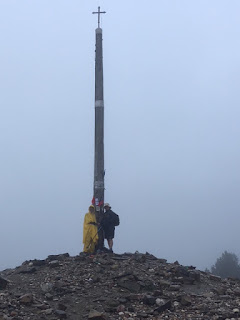We awoke to the sound of soft rain against the window from our mountain village of Rabanal de Camino and through every pilgrim into a paroxysm of panic. Today's walk was steep and uphill on a narrow gravel path, to the highest point on our journey, and then just as steep downhill over the mountain pass. After so many days of the Meseta this was a harsh change of terrain through the Leon Mountains.
By the time we had finished breakfast, the soft rain had become a torrent, and it was clear that the rain gear lounging in our pack was finally needed.
 |
| all over visible |
 |
| rain gear on top and the usual bare legs on Martin! |
Add to this was the majestic Cruz de Ferro, the famed iron cross that has become one of the key points of the Camino. Nothing for it but to dress accordingly and plunge into the rain and wind to begin our ascent.
One thing good about walking in the mist of a cloud is that distractions are at a minimum and it is easy to focus on each step rather than slip while admiring the views as we climbed. As a result, we arrived at the iron cross wet but in good shape, and could see it for what it is and not for the views its height would normally command.
The Iron Cross and the mountain of stones surrounding it has a long history, long before the Camino was walked for the first time. Pre-Roman Celts were in the habit of marking mountain passes with stone piles (cairns) and there were lots of Celts in this neck of the woods. Romans themselves also marked high passes with stones (murias) in honour of Mercury, the patron god of travellers. So when a Christian hermit named Gaucelmo stuck a cross made of iron on top of this pass and its pile of stone, he basically Christianized a pagan structure. An earlier cross is in the museum in Astorga (16th century), with a less wind-eaten one in its place.
 |
| original iron cross |
Regardless, it has become a key point of the Camino, and a photo op for all. Us included, as we left behind the small stones we brought from home, from a beach on the other side of the world. It would have been nice to sit and reflect on the centuries of stones and other objects brought be pilgrims from all over the world, but it was cold, it was wet, and there were a lot of people who wanted their moment at the top. As there was not much of a view to take in either, we stepped down and looked at the pile from a distance.
 |
| the mass collection of stones and other objects left behind |



No comments:
Post a Comment